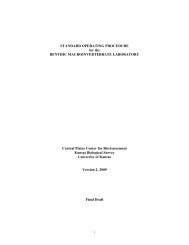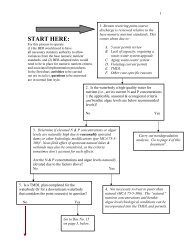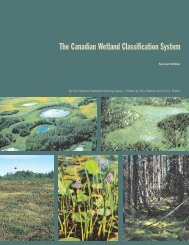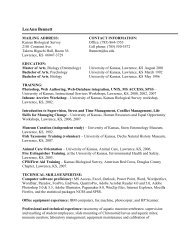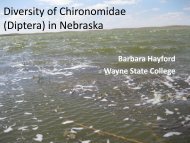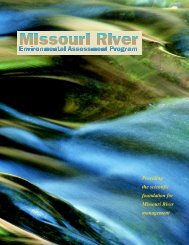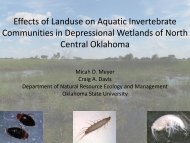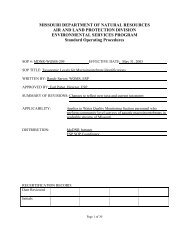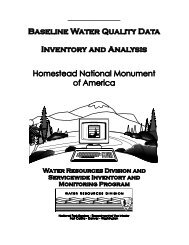Koontz, J., D.G. Huggins, C.C. Freeman, D.S. Baker - Central Plains ...
Koontz, J., D.G. Huggins, C.C. Freeman, D.S. Baker - Central Plains ...
Koontz, J., D.G. Huggins, C.C. Freeman, D.S. Baker - Central Plains ...
You also want an ePaper? Increase the reach of your titles
YUMPU automatically turns print PDFs into web optimized ePapers that Google loves.
suspected that differences in sampling dates, and subsequent precipitation and runoff amounts<br />
might have affected concentrations of both nutrients and pesticides. Trends in herbicides seen in<br />
this wetland defy what was found in herbicide use trends and detections in this region. From<br />
1996 to 2006, pesticide use and concentrations decreased; unless there was some dramatic<br />
increase in herbicide use after 2006, the herbicide data may be suspect. However, if we consider<br />
some significant relationships between water quality and observations made in the disturbance<br />
assessment, we can explain some of these discrepancies. First, a significant positive relationship<br />
exists between chlorophyll-a concentrations and turbidity (R 2 = 0.46), which indicates that much<br />
of the solar adsorption interference can be accounted for by higher productivity by sestonic<br />
phytoplankton. In 2005 the survey was conducted in mid-July, the water table was quite low,<br />
organic nitrogen and phosphorus concentrations dominated the total nitrogen and phosphorus<br />
concentration, chlorophyll-a concentrations were high, and no indication of sedimentation was<br />
observed in the disturbance assessment. In 2008, sedimentation was indicated, though turbidity<br />
was lower, the water table was high, indicators of productivity (total nitrogen and phosphorus<br />
and chlorophyll-a) were lower, but herbicides had higher concentrations and more of them were<br />
detected. Alachlor, metachlor, and cyanazine have higher octanol water coefficients (Koc) yet<br />
higher solubility in water than atrazine, which was detected in significantly higher concentrations<br />
in 2005 than 2008. Metribuzine and atrazine have the longest aerobic soil half lives of all<br />
measured herbicides, and they were the only herbicides detected in 2005. These inherent<br />
qualities, coupled with differences in year to year and seasonal precipitation and runoff, may<br />
explain these significant water quality changes.<br />
Another scenario was observed where sites along the littoral zone of Browns Lake were sampled<br />
in both 2005 and 2008. The two zones are characteristically different in plant community<br />
structure and some water quality measures. In 2005, no herbicides were detected but there were<br />
six found in the 2008 water sample. The 2005 macroinvertebrate MMI score was slightly higher<br />
than in 2008, though there was only a 3 point difference between them. FQI and richness values<br />
were significantly higher in 2005 when the site had a more varied water depth regime with<br />
subsequent increased interspersion allowing for a greater diversity of plants. Both dissolved<br />
oxygen and nutrient concentrations were higher in 2005 than 2008 but dissolved oxygen levels<br />
can vary greatly just from the time of day of the measurement as well as from short-term climatic<br />
conditions such as cloud cover.<br />
Cooley Lake, an AB site, was sampled during the 2005 and 2008 seasons. Comparison of<br />
sampling results from this wetland also illustrates that changes can occur as a result of temporal<br />
change and hydrological shifts. The 2005 sample year was very dry, and wetland water tables<br />
were low in comparison to the 2008 season. Though FQA values were similar overall, plant<br />
species richness was dramatically higher in 2005 than in 2008. Some water quality parameter<br />
shifts were thought reflected influence of hydrological or temporal change. Ammonia,<br />
orthophosphate, and herbicide concentrations were much higher in the 2008 season than in the<br />
2005 season, suggesting that increased runoff from the surrounding landscape had occurred<br />
during 2008. However, total nitrogen, total phosphorus, and chlorophyll-a concentrations were<br />
higher in 2005 a time of overall drier conditions. The high nutrient levels in 2005 which would<br />
also be a normal part of runoff don‟t support the increased runoff argument for ammonia,<br />
orthophosphate and herbicides.<br />
53 of 84



